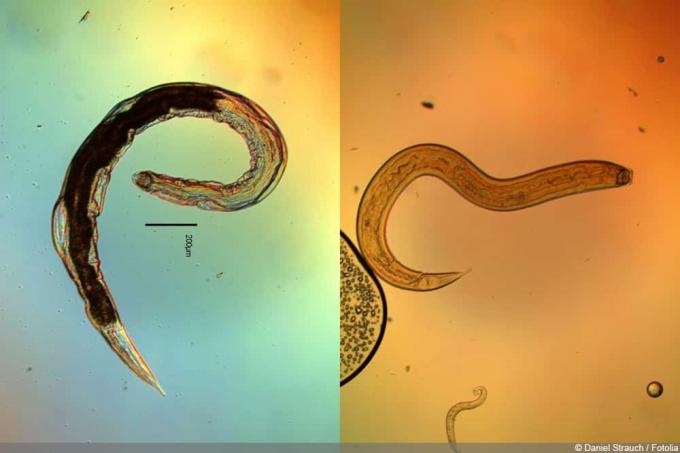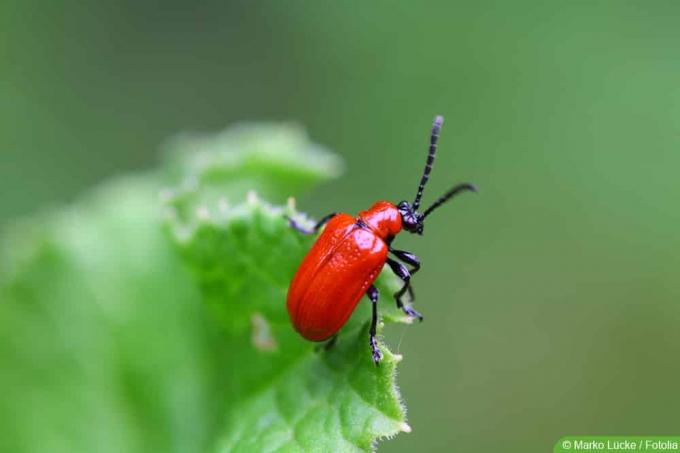

Table of contents
- Low pest spread
- Attract
- Scare off
- barriers
- Targeted fight
- Prevent
If you see caterpillars in the raised bed or garden, you should act quickly. If the pests are not discovered in time, the population will expand significantly within a short period of time. To combat the plague, home remedies can be used as a deterrent or barrier. Targeted prevention of the spread of pests is better than fighting them.
Low pest spread
If the infestation is not very advanced, you can collect and dispose of the pests at dusk. This measure is carried out until the number of cutworms has visibly reduced. Regular follow-up checks during the summer months are necessary to eliminate pests that appear later.
Attract
Cutworms are nocturnal and retreat to burrows they have dug themselves during the day. This way of life makes it difficult to collect the pests. They can be deliberately lured out of their hiding places. A mixture of bran, sugar and water is suitable as bait.
- 200 grams of oat bran
- three tablespoons of sugar
- twice the amount of water
- some ground bitterwood
Scare off
Cutworms are sensitive to the smell of some substances. Essential oils and intense aromas keep annoying creatures away from the raised bed and garden.
Spices

Dried kitchen herbs contain essential oils that have a repellent effect on cutworms. Regularly mix a teaspoon of thyme or sage into the irrigation water and let the extract stand for a while before administration. Young plants can be watered with the tea. Garlic has effects similar to intensely fragrant spices. Sprinkle the powder on the ground or plant garlic plants in the bed. A cut garlic clove in the substrate exudes an intense scent and keeps the pests away.
Tip:
In mixed cultures there is less risk of pest spreading. Place tomato plants in the garden and raised bed, because their aroma deters caterpillars.
tobacco
The smell of cigarette butts has a deterrent effect on the offspring of the voracious butterflies. As a preventive measure, fresh tobacco can also be spread on the substrate. It should be used with care, as tobacco contains a highly effective neurotoxin. It also damages other organisms and must not get into the soil.
Tip:
The roasted aromas of the coffee powder have a deterrent effect on many pests. Sprinkle coffee grounds regularly on the substrate as an alternative to tobacco.
barriers
Some home remedies have proven to be effective barriers that the pests find difficult to overcome. They are suitable as gentle alternatives to pesticides.
eggshells

Finely ground eggshells are distributed around the shoot base of the plants as a natural barrier. The pests cannot overcome the sharp-edged pieces of shell without injuring themselves. They lose fluid and die after a while. Crushed eggshells are also good for preventing snail damage. Similar to diatomaceous earth, this method results in slow death. Spreading eggshells offers advantages for the environment and other living beings.
- environmentally friendly method
- Leftovers are recycled
- Egg shells provide a calcareous food source for birds
molasses
The tough substance prevents the caterpillars from moving to the base of the stem. The barrier effect is reinforced by sawdust and wheat bran mixed with the molasses. If the pests try to crawl over the mass, it sticks to the body and makes further movement difficult. The pests can be collected and disposed of to save them a slow death.
Tip:
Since the caterpillars dig holes, you should spread the thick mass near the base of the stem. Draw circles around the plant.
plant collar
Self-made collars, which are placed in the substrate around each individual plant, are suitable for plants in raised beds. For this you can use tin cans or leftover plastic, which you cut to size accordingly. The collars should be about ten centimeters high so that the cutworm cannot climb over the obstacle. They are inserted about 2.5 centimeters deep into the substrate.
- easy to make
- inexpensive and ecological
- suitable for small beds with few plants
Targeted fight
If the pest infestation was not discovered in time, the population may have already expanded significantly. In this case, fighting the caterpillars directly with lethal agents helps.
corn grits
The caterpillars like to eat the powder. This is how the fine grains get into the digestive tract, where they wreak havoc. Large amounts of maize grits lead to the death of the pests. Spread the powder on the substrate. You should use the remedy with care, as the sweet scent could attract other pests.
kieselguhr
It consists of finely ground fossils and represents an ecological variant because diatomaceous earth does not harm humans, plants or other animals. The powder contains a glass-like quartz dust whose grains are very sharp-edged. They damage the outer skin of the cutworm, causing it to dehydrate and slowly die. The mealy dust settles on the surface of the pests. It destroys the lipid layer of the outer skin, which protects the caterpillars from dehydration. The disadvantage of this method is that the caterpillars die very slowly and it can take a long time to dry out an entire population.
- powdery agent for controlling cutworms
- can be spread at any time
- Rain washes away the powder
roundworms

The beneficial insects, known as nematodes, live in the substrate. They reach a length of 0.6 millimeters and prove to be natural opponents of numerous larvae that live in the soil and on the substrate. The species Steinernema carpocapsae has specialized on cutworms. They kill the caterpillars and feed on the tissue. In order for the nematodes to be able to survive, the temperature in the soil must be above 14 degrees Celsius for a few hours. A temperature drop at night does not harm the beneficial insects.
- Nematodes are available in powder form
- Powder is mixed with water and poured onto the substrate
- Beneficial insects can be used between May and September
bacteria
Bacillus thuringiensis is one of the beneficial bacteria that kills cutworms. Since they also do not destroy harmful species of moths and butterflies, the bacteria should be used with caution. They are applied directly to the substrate and can be used both for targeted control and as a preventive measure. In order to permanently protect young plants from pest infestation, the agents are used until the plants have developed strong stems.
- Bacteria are available as a pesticide
- delivery in the afternoon
- apply again after rain
Prevent
The first feeding period ends in spring. In the coming months, the moths look for places to lay their eggs. Weeds and grasses, whose plant parts die off in autumn, offer optimal protection for eggs with their hollow stalks. Removing withered plants will prevent egg laying. This measure also ensures that beneficial insects do not find sheltered spots. It is better to plant different types of plants so that an intact habitat is created. Beneficial animals such as toads, meadow larks or fireflies can spread in cultures with a large variety of plants.
 garden editorial
garden editorial I write about everything that interests me in my garden.
Learn more about plant pests

White spots on leaves: what to do?
Whether in the home or in the garden, white spots on the leaves of your favorite plants are always a cause for concern. However, the causes can often be eliminated quickly. This guide summarizes the most common triggers and gives tips for quick help.

Cherry laurel has yellow eaten leaves: what to do?
Despite the robust nature of Prunus laurocerasus, it is occasionally attacked by pests and fungi. An infestation can be recognized by feeding damage and the discoloration of the leaves to yellow. You can find out how to combat and prevent the accumulation here.

Fighting grubs | Protect raised bed & lawn
Larvae of various species of beetles, grubs, can do a lot of damage in the garden. They live in the ground for several years and prefer to feed on roots. We present effective methods to combat the voracious pest or to effectively prevent an infestation.

Worms in cherries - 8 tips against maggots in cherries?
Worms in sweet cherries can spoil your appetite. It is a major nuisance when the entire cherry crop is affected. With these tricks you can contain the pest infestation and ensure that the insects do not multiply any further.

Fighting lily beetle - 11 effective home remedies
Lilies in the garden are beautiful to look at. There are the greatest types and varieties, all of which somehow have something special. Lily lovers can draw from the abundance of offers and look forward to the floral splendor. Lilies are actually quite hardy. There are few diseases and pests that can cause damage. However, the lily chicken can spoil the splendor.

Combating fungal infestation on trees: how to remove tree fungi
A tree fungus does not appear threatening, sometimes it is even interesting to look at. But that is deceptive. What we see is only the fruiting body, the mycelium is deep in the wood and destroys it slowly but purposefully. Eventually it kills the strongest tree.


